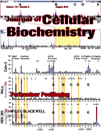
NEUROCHEMISTRY INTERNATIONAL
Scope & Guideline
Fueling Scientific Collaboration in Neurobiological Innovations
Introduction
Aims and Scopes
- Neurodegenerative Diseases:
The journal emphasizes research on the biochemical pathways and molecular mechanisms involved in neurodegenerative conditions such as Alzheimer's, Parkinson's, and multiple sclerosis, exploring potential therapeutic interventions. - Neuroinflammation:
Investigations into the role of neuroinflammation in various CNS disorders, including the mechanisms of microglial activation, cytokine signaling, and the impact of inflammation on neuronal health and function. - Nutraceuticals and Natural Products:
Research focusing on the neuroprotective effects of dietary compounds and natural products, examining their potential in modulating neurochemical pathways and improving cognitive function. - Stem Cell and Regenerative Medicine:
Exploration of stem cell biology and its applications in neuroprotection and repair, including the use of induced pluripotent stem cells (iPSCs) and other regenerative strategies to restore neuronal function. - Oxidative Stress and Antioxidant Strategies:
Studies on the role of oxidative stress in neuronal injury and the therapeutic potential of antioxidants and other compounds in mitigating oxidative damage. - Molecular and Cellular Mechanisms:
Research that delves into the molecular and cellular underpinnings of neurological conditions, including signaling pathways, gene expression, and protein interactions that affect neuronal survival and function.
Trending and Emerging
- Neuroinflammation and Neuroimmune Interactions:
Research focusing on the interplay between neuroinflammatory processes and immune responses in the CNS is gaining traction, revealing insights into the pathogenesis of various neurological disorders. - Gut-Brain Axis and Microbiome Influence:
Emerging studies investigating the relationship between gut microbiota and neurological health are trending, highlighting the importance of the gut-brain axis in neuroinflammatory and neurodegenerative conditions. - Epigenetic Regulation in Neurobiology:
A growing body of research is exploring how epigenetic modifications affect neuronal function and contribute to the pathology of neurological disorders, emphasizing the potential for epigenetic therapies. - Nanotechnology and Drug Delivery Systems:
Innovative approaches using nanotechnology for targeted drug delivery and neuroprotection are on the rise, reflecting advancements in biomaterials and their applications in neurological therapies. - Biomarkers for Neurological Disorders:
The identification and validation of novel biomarkers for early detection and monitoring of neurological diseases are emerging as a critical area of research, facilitating personalized medicine approaches.
Declining or Waning
- Traditional Pharmacological Approaches:
Research on conventional pharmacological treatments for neurological disorders appears to be less prominent, with a growing emphasis on alternative therapies, nutraceuticals, and integrative approaches. - Basic Animal Model Studies:
There is a noticeable decline in the publication of studies focused solely on basic animal model research without translational implications, as the field moves toward studies with direct clinical relevance. - Purely Descriptive Studies:
The journal has shifted away from purely descriptive studies that do not contribute new insights into mechanisms or therapeutic targets, favoring more hypothesis-driven research. - Single-Target Therapeutic Approaches:
Research exploring single-target therapies is becoming less common, with a trend toward multi-target strategies that consider the complexity of neurological disorders. - Studies on Non-CNS Related Neurological Disorders:
There is a waning interest in research that primarily focuses on neurological disorders not directly linked to central nervous system mechanisms, as the journal emphasizes CNS-centric studies.
Similar Journals

MOLECULAR AND CELLULAR BIOCHEMISTRY
Pioneering Insights in Biochemistry and MedicineMOLECULAR AND CELLULAR BIOCHEMISTRY, an esteemed journal published by SPRINGER, serves as a prominent platform in the fields of biochemistry and molecular biology. With a history of dissemination since 1973, this journal has made significant contributions to the understanding of biochemical processes at the molecular level. The MOLECULAR AND CELLULAR BIOCHEMISTRY journal focuses on a myriad of topics including but not limited to cellular biochemistry, clinical biochemistry, and interdisciplinary approaches in medicine, boasting a commendable categorization in the 2023 Scopus ranks where it falls under Q3 in Cell Biology, Q2 in Clinical Biochemistry, Q1 in Medicine (miscellaneous), and Q2 in Molecular Biology. Although the journal is not open access, it provides access options through institutional subscriptions, making valuable research accessible to a wider audience. With its rigorous peer-review process and high impact within the scientific community, this journal aims to advance knowledge and stimulate exploration in biochemical research, making it essential reading for researchers, professionals, and students alike.

CELLULAR & MOLECULAR BIOLOGY LETTERS
Illuminating Cellular Processes Through Open Access ResearchCELLULAR & MOLECULAR BIOLOGY LETTERS, published by BMC, is a premier open-access journal dedicated to disseminating high-quality research in the fields of Biochemistry, Cell Biology, and Molecular Biology. Established in 1996, the journal has emerged as a leader in its domain, boasting an impressive Q1 ranking across three critical categories as of 2023, reflecting its significant impact within the scientific community. With an ISSN of 1425-8153 and an E-ISSN of 1689-1392, it offers accessible research findings to a global audience, having been open access since 2013. Situated in the United Kingdom, at CAMPUS, 4 CRINAN ST, LONDON N1 9XW, the journal continues to serve as a vital resource for researchers, professionals, and students, contributing to advancements in the understanding of cellular and molecular processes. By providing a platform for original research, reviews, and short communications, CELLULAR & MOLECULAR BIOLOGY LETTERS plays a crucial role in fostering dialogue and collaboration within the scientific community.

Inflammation and Regeneration
Pioneering research at the intersection of inflammation and healing.Inflammation and Regeneration is a prominent open-access journal published by BMC, focused on the discerning fields of immunology, cell biology, and regenerative medicine. Since its establishment in 2016, the journal has provided a platform for the dissemination of high-quality research, contributing significantly to the advancement of knowledge in inflammation processes and regenerative therapies. With a remarkable impact reflected in its Q1 quartile rankings in Cell Biology and Immunology for 2023, Inflammation and Regeneration stands out as a leading resource for researchers and practitioners. The journal's commitment to open access ensures that critical findings are readily available to a global audience, fostering collaboration and innovation in the scientific community. With a Scopus ranking that places it in the top 20% of its categories, Inflammation and Regeneration serves as an essential reference for those seeking to stay at the forefront of immunological research and its applications.

JOURNAL OF CELLULAR BIOCHEMISTRY
Advancing the Frontiers of Biochemical ResearchJournal of Cellular Biochemistry is a premier academic journal dedicated to advancing the field of biochemistry and cellular biology. Published by Wiley, this influential journal has a significant impact factor that underscores its relevance and authority within the scientific community. With its ISSN 0730-2312 and E-ISSN 1097-4644, the journal has been on the frontier of research since its inception in 1982, and is expected to continue publishing cutting-edge studies through 2024. As evidenced by its ranking in the 2023 Scopus Quartiles, it holds a rank of Q2 in Biochemistry and Q3 in both Cell and Molecular Biology, placing it among the top tiers of scientific journals in these disciplines. The Journal of Cellular Biochemistry serves as a vital resource for researchers, professionals, and students alike, providing a platform for the dissemination of innovative ideas and findings that shape our understanding of cellular processes and biochemical pathways. Though it does not currently offer Open Access options, its robust peer-review process ensures that each publication meets the highest academic standards, thus solidifying its esteemed position in the landscape of biochemical research.

MOLECULAR AND CELLULAR NEUROSCIENCE
Unraveling the Complexities of Neural FunctionMOLECULAR AND CELLULAR NEUROSCIENCE, published by Academic Press Inc Elsevier Science, is a pivotal journal dedicated to the expansive fields of Cellular and Molecular Neuroscience, providing a platform for the dissemination of innovative research and theoretical advancements since its establishment in 1990. With an ISSN of 1044-7431 and a commitment to high scholarly standards, this journal holds a notable Q2 ranking in key categories such as Cell Biology and Molecular Biology, highlighting its significant impact within the academic community. Although currently not an Open Access journal, it offers a wealth of insightful contributions aimed at fostering understanding and collaboration among researchers, professionals, and students. The journal's ongoing publication trajectory through to 2024 guarantees a continuous flow of cutting-edge research that is critical for addressing complex questions in neuroscience. As it plays a crucial role in advancing our understanding of molecular mechanisms underpinning neural function and pathology, MOLECULAR AND CELLULAR NEUROSCIENCE remains an essential reference for anyone invested in these dynamic fields.

FEBS Journal
Catalyzing Progress in Biochemistry and BeyondFEBS Journal is a prestigious, peer-reviewed publication dedicated to advancing the field of biochemistry, cell biology, and molecular biology. Published by WILEY in the United Kingdom, this journal boasts an impressive impact factor and ranks in the top quartile (Q1) across multiple relevant categories, including Biochemistry, Cell Biology, and Molecular Biology, reflecting its significant contribution to scientific research. With an ISSN of 1742-464X and an E-ISSN of 1742-4658, the FEBS Journal publishes original research and comprehensive reviews that push the boundaries of knowledge and innovation in the biosciences. As a vital resource for researchers, professionals, and students alike, the journal offers Open Access options, ensuring that cutting-edge discoveries are accessible to a broad audience. With a publication history converging from 2005 to the present and a robust emphasis on high-quality scholarly work, the FEBS Journal remains an essential platform for the dissemination of significant findings and advancements in the life sciences.

Translational Neurodegeneration
Fostering Excellence in Neuroscience ResearchTranslational Neurodegeneration, an esteemed journal in the field of neuroscience, is published by BMC and has been an open access platform since 2012, delivering high-quality research from its base in the United Kingdom. With an impressive impact factor reflecting its significant contributions, this journal focuses on critical advancements in cellular and molecular neuroscience, cognitive neuroscience, and clinical neurology, boasting a Q1 ranking across all these categories as of 2023. Researchers and professionals benefit from its extensive reach, characterized by exceptional Scopus rankings that place it in the top percentile of its field. The journal serves as a vital resource for academics and healthcare practitioners alike, aiming to bridge the gap between laboratory discoveries and clinical applications, thereby enhancing understanding and treatment of neurodegenerative diseases. With its commitment to open access, Translational Neurodegeneration ensures that its published research is accessible to a global audience, promoting collaboration and knowledge exchange within the scientific community.

Genes & Diseases
Shedding light on the genetic foundations of disease.Genes & Diseases, published by KEAI PUBLISHING LTD, is a premier open-access journal dedicated to advancing the fields of genetics, biochemistry, and molecular biology. Established in 2014 and headquartered in Beijing, China, this journal has quickly risen to prominence, securing a place in the prestigious Q1 quartile in Biochemistry and Genetics (clinical), as well as Q2 in Cell Biology and Q1 in Molecular Biology as of 2023. With a commitment to disseminating cutting-edge research, Genes & Diseases serves as a critical platform for researchers, professionals, and students alike, ensuring that high-quality scientific work is openly accessible to the global community. The journal's exceptional impact is underscored by its selective Scopus rankings, which reflect its influence and relevance in key scientific domains, making it an essential resource for those exploring the intersections of genetics and disease pathology.

AMERICAN JOURNAL OF RESPIRATORY CELL AND MOLECULAR BIOLOGY
Unveiling New Horizons in Cell and Molecular BiologyThe AMERICAN JOURNAL OF RESPIRATORY CELL AND MOLECULAR BIOLOGY, published by the esteemed American Thoracic Society, is a premier platform dedicated to advancing knowledge in the fields of pulmonary and respiratory medicine, cell biology, and clinical biochemistry. With an impressive impact factor and recognition as a Q1 journal in multiple categories for 2023, it ranks among the top tier of scholarly publications, evidencing its influence and contribution to the scientific community. Since its inception in 1989, the journal has provided a critical forum for researchers and professionals to disseminate innovative findings and pivotal reviews, driving forward the frontiers of respiratory biology. While the journal currently operates under traditional access mechanisms, it seeks to bridge gaps in research by presenting high-quality articles that address vital health challenges. As a key resource for both established researchers and emerging scholars in molecular biology and respiratory science, this journal plays a pivotal role in shaping the future of respiratory health advancements.

Molecular Brain
Pioneering Research in Cellular and Molecular Mechanisms of the BrainMolecular Brain is a prestigious open-access journal published by BMC, dedicated to advancing the field of neuroscience with a particular focus on cellular and molecular mechanisms. Since its inception in 2008, the journal has been committed to disseminating high-quality research that explores the intricate workings of the brain, particularly in areas related to cellular and molecular neuroscience. Located in the heart of London, England, Molecular Brain has garnered significant recognition in the academic community, boasting a 2023 categorization in the Q2 quartile for both Cellular and Molecular Neuroscience and Molecular Biology, reflecting its growing influence and relevance in these fields. With its Scopus ranks placing it in the top 32% and 38% of its respective categories, the journal serves as an essential platform for researchers, professionals, and students alike, encouraging collaboration and knowledge-sharing through its accessible online format.